A well-structured and installed kitchen sink has the power to enhance the look of a kitchen. The materials used to make a sink play a vital role in the performance of a kitchen sink. Two significant elements of kitchen sinks are porcelain and stainless steel.
This article highlights all crucial information regarding Porcelain vs. Stainless Steel Kitchen sinks. The covered topics are:
- Side-by-side comparison
- Main Distinguishing Factors Between Porcelain and Stainless Steel Kitchen Sink
- Porcelain Kitchen Sink Pros and Cons
- Stainless Steel Kitchen Sink Pros and Cons
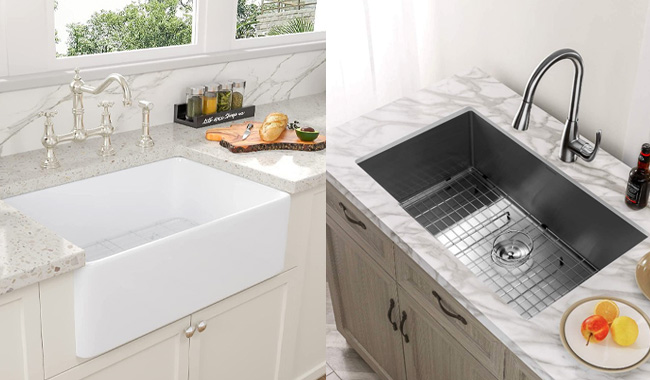
The Fundamental Difference Between a Porcelain Sink and a Stainless Sink
The porcelain holds a timeless fashion. The smooth look is eye soothing. Unfortunately, porcelain sinks are prone to scratch also.
In the case of stainless steel sinks, they are easy to install, look reasonably good, and have less chance of scratches.
Side-By-Side Comparison: Porcelain Vs. Stainless Kitchen Sink
| Sink Type | Porcelain Sink | Stainless Steel Sink |
| Durability | Relatively more durable | Less durable |
| Look and Shape | Traditional | Contemporary |
| Maintenance | Easy to clean and maintain | Relatively complex |
| Soundproof | Quiet sink | Noisy |
| Eco-Friendly | Up to 80% recyclable | Totally recyclable |
| Installation | Not easy to install | Easy to install |
| Appropriate Utensils | Glass items are not suitable | All utensils are suitable |
| Price | Bit expensive | Less expensive |
Main Distinguishing Factors Between Porcelain and Stainless Steel Kitchen Sink:
Look and Shape
Winner: Stainless Steel Sink
The best part of stainless steel sink is that it is available in various shapes and styles. Be it a home or resort, or a cafe, and a stainless sink fits in instantly. It looks bright, polished, and attractive. The 16 to 18-gauge stainless steel sink is highly popular.
One of the best advantages is that the style and shape are not limited to only one type. Different types are available. It is also available in clean line edge format and rounded edge format.
In the case of porcelain sinks, the look and shape are traditional. Mostly, the white color sink is available everywhere. However, it lacks a wide variety.
Durability
Winner: Porcelain Kitchen Sink
Generally, stainless steel sinks start to get problematic after 15 years. In the case of a porcelain sink, it runs 25 years at a stretch without any significant problem. Both types of sinks run up to 30 years at best.
The porcelain runs longer because of its manufacturing process. A good number of porcelain sinks are made of solid porcelain, and with that, there is steel inside or cast iron covered at the center on which there is baked-on porcelain that forms a strong finish.
In the case of stainless steel, things are good too. But strong cleaning chemicals, bleach, and acid create stains and visible marks on the sink in case of heavy use.
Recommended reading: 16 Vs 18 Gauge Stainless Steel Sink
Maintenance
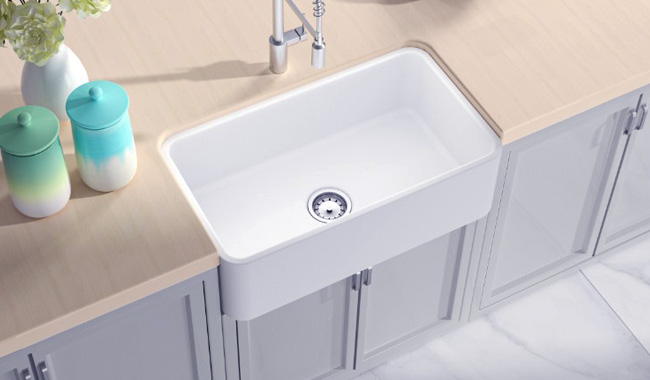
Winner: Porcelain Kitchen Sink
The best part of a porcelain sink is it requires no hassle for cleaning and maintenance. Almost any cleaning material can be used for cleaning a porcelain sink. For the effective enamel of the porcelain, there is less possibility of scratch and stain.
On the other hand, stainless steel sinks are prone to scratches and stains. Therefore, for the cleaning process, you should avoid harsh chemicals.
Soundproof
Winner: Porcelain Kitchen Sink
The porcelain sink is a winner because it is thicker than stainless steel and does not vibrate each time utensil is kept on it. In addition, the porcelain sink is quiet. Even if there is sound or noise that is subdued, generally, it does not create a loud noise.
As stainless steel is thinner than porcelain, it makes loud sounds when water drops or utensils are cleaned. As stainless steel sinks produce high volume noise, producers put a pad on the bottom to reduce the sound volume.
Eco-Friendly
Winner: Stainless Steel Sink
Yes! Stainless steel is completely recyclable. Fresh new stainless steel sinks are manufactured from recycled steel. If you focus heavily on environmental concerns, a stainless steel sink is your pick.
On the other hand, porcelain coating makes it non-recyclable after use for a long time. There are cast iron at the base of some porcelain sinks. This is a recyclable item.
Installation
Winner: Stainless Steel Sink
One of the significant features of stainless steel sinks is – that they are lightweight. So, even if the sink is large in size, you can move it easily. In the case of a porcelain sink, moving and placing it is very tough due to its heavyweight.
It is prone to breakage also. But on the other hand, stainless steel sinks are not prone to breakage.
The stainless steel sink has very few mounting clips, for which it is quite easy to install. Among all the types of stainless steel sinks, drop-in sinks are the most convenient to install. It is DIY.
A porcelain sink is heavier than a stainless sink and takes a long time to install with additional equipment.
Appropriate Utensils
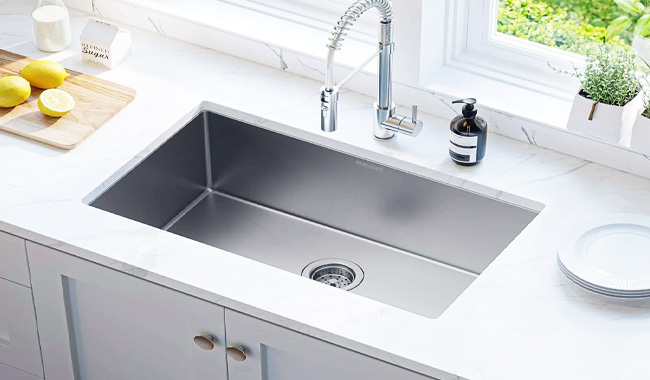
Winner: Stainless Steel Sink
Even if you mistakenly drop a glass or dish in a stainless steel sink, there is hardly any chance of breakage. So any type of utensils made of glass or plastic or marble stone is safe to clean in a stainless steel sink.
Stainless steel is thinner. That is why it sucks up the movement of items falling in.
On the flip side, porcelain sinks are heavier, so they can’t take in the vibration of any object. As a result, the dish and glasses get cracked or distorted.
Price
Winner: Stainless Steel Sink
Yes, stainless steel sinks are less expensive than porcelain sinks. Stainless steel is less costly than not only porcelain but also sinks made of granite and cast iron.
Regardless of the gauge and installation procedure, stainless steel costs less and is an excellent option for customers with tight budgets. The core sink is budget-friendly, but the installation charge is also low.
The cost is less because it does not require complex steps or heavy supportive materials to install.
In the case of a porcelain sink, it has a high cost. In addition, it requires a good amount of supportive hardware to install, which you need to buy at an additional price.
According to a survey, the setup cost for an undermount stainless steel sink is $150, whereas you need to pay a minimum of $200 to install an undermount porcelain sink.
Recommended reading: Best Undermount Kitchen Sinks
Final Verdict for Price:
Best sink for tight budget customers:
So, if you are on a tight budget, a stainless steel sink is the best option for you. At $200, you can buy a modern stainless steel sink for your home. There are many designs in stainless steel sinks that have varied price ranges, though.
Best sink for budget-friendly customers:
You can buy a basic porcelain kitchen sink if you are on a medium budget. It will cost from $300 to $400.
Best sink for luxury budget customers:
If you do not have budget constraints, you can choose to buy a farmhouse porcelain kitchen sink. However, it will cost $600.
Porcelain Kitchen Sink Pros and Cons
Pros
- Trendy in any season
- Available in numerous colors
- Beautiful and smooth to use
- Does not make any noise
- Hassle-free maintenance
- Works for a longer time, like 30 years
Cons
- Prone to scratch or lasting crack
- Not easy to install because of heavyweight
- Heavy bleaching needed to remove stains
- Loss the brightness with time
- Limited contemporary style
Stainless Steel Kitchen Sink Pros and Cons
Pros
- Gets upgraded quickly
- Easy to install
- Completely recyclable material
- Works between 15 to 30 years
- No crack, stain, or scratch
- Less expensive
Cons
- Generally noisy
- Available with silver color mainly
- More maintenance needed
- If it remains wet for long, stains start to show up
FAQs
- What is porcelain made of?
Ans: porcelain which is also known as ceramic, is made of – clay, kaolin, quartz, and feldspar.
- Do porcelain sinks stain?
Ans: Yes, traditional white porcelain sinks get stained with regular use.
- Do stainless steel sinks last?
Ans: Yes, it lasts from 15 to 30 years.
- Is porcelain harder than stainless steel?
Ans: Yes, a porcelain sink is harder than stainless steel
- Are porcelain sinks outdated?
Ans: No, porcelain sinks are never outdated. Due to its unique feel and look, it has universal appeal. It is timeless.
- Do porcelain sink chips easily?
Ans: yes, as porcelain is a vulnerable material, it chips easily.
All in all
Porcelain vs. Stainless Steel Kitchen Sink is always a good consideration. It offers a lot of issues to analyze before choosing to buy one.
Porcelain and stainless steel sinks both have their merits and drawbacks. It depends on you to pick between them. Both are useful and effective. Both the porcelain and stainless steel kitchen sinks have similarities also.
The buying decision mainly depends on the budget and intention of use and liking.
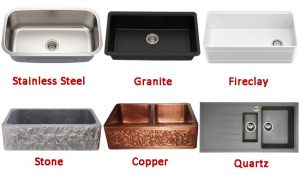
10 Best Kitchen Sink Materials with Pros & Cons
The most significant factor for a kitchen sink’s overall durability is the material used to make it. However, with the plethora of brands offering multi-variational
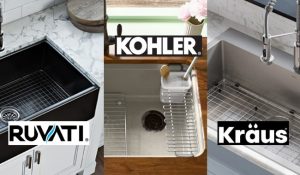
Ruvati Vs Kraus Vs Kohler Kitchen Sink: Which is Best?
Kitchen is the heart of your home, and the sink keeps it tidy. Unfortunately, a bad kitchen sink can sink your day. You can’t cheap
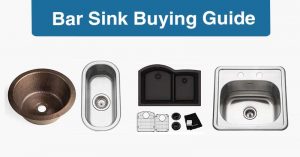
Bar Sink Buying Guide | How to Choose The Right One
Have you shifted to a new house? Are you planning a change in the interior design? Are you prepping up to buy a bar sink?
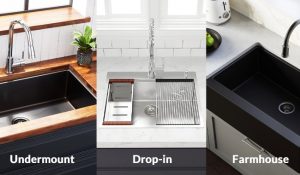
Undermount vs. Drop-in vs. Farmhouse Kitchen Sink
It is tough to imagine a house without a kitchen, right? Imagine you are planning to make a special meal and you have no sink

13 Best Undermount Kitchen Sinks for Granite Countertops [2023 Updated]
We have recharged a lot of undermount kitchen sink and found out 13 best undermount kitchen sink for granite countertops for you. Grabbing the best

Different Types of Kitchen Sinks in Detail
Till today I had no idea that there are so many types of kitchen sink available in the market. If you are about to renovate



